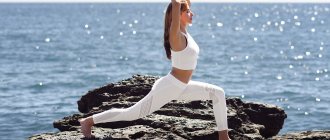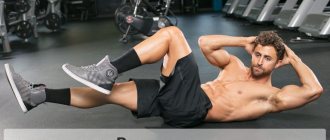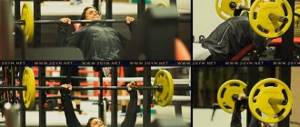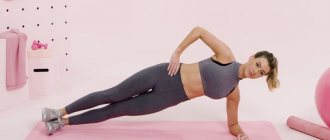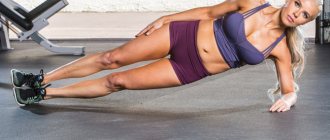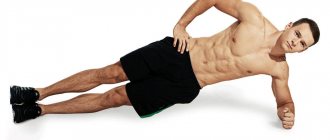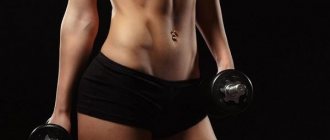Let's talk about this in more detail and find out whether this exercise is as effective as they say.
At some point, the whole world went crazy and the plank became mainstream. It seems to me that if you have never stood in the plank, then you could become an outcast.
Children at school will mock you, minibus drivers will close the door in your face, even though you ran a hundred meters to the stop faster than Usain Bolt. If you don't plank for at least 30 seconds, you might not even be hired if they found out.
So everyone started doing the plank, because it was necessary, because everyone was doing it.
In this article, I will tell you what this wonderful plank exercise does, why you should do it, and whether it really is effective.
What muscles work?
The attractiveness of the plank, both for beginners and professional athletes, is due to the positive effect on the main muscle groups:
- The back muscles are subjected to significant strengthening loads, during which everything is worked out, from the cervical region to the deep back muscles.
- The arm muscles take on half the weight of your body and become stronger after each approach without changing their volume - the arms remain slender and graceful.
- Abdominal muscles - while doing the plank, you will more than once feel their treacherous trembling. The plank helps shape the abdominal contour and allows you to work out problem areas - the lateral and lower abdominal muscles.
- The leg muscles are where most of the weight of a novice athlete’s body falls. During an elbow stand, everything is tense - from the thighs to the calves.
- The gluteal muscles are the favorite part of the fair half of humanity. The elbow plank allows you to significantly strengthen the three paired muscles of the gluteal region - large, medium and small, and also helps get rid of cellulite in this traditionally difficult area of our body.
Interesting fact:
The elbow plank puts increased stress on the abdominal muscles and is a popular and reliable solution for creating sculpted abs.
Complicated variations of the plank exercise
As your training level increases, the plank begins to seem like a simple exercise, which means you can use more complicated versions of it:
1. Plank with push-ups
Taking the position of a classic plank (a), lift your body up, doing push-ups on your hands (b). At the top point, pause (c) and return to resting on your elbows.
2. Plank with jump
Taking the position of a classic plank (a), jump up, spreading your legs to the sides (b). In this case, the upper part of your body should not turn. Next, the legs must be quickly returned to their original position.
3. Plank with arm extension
Once in a classic plank position (a), lift your left arm and extend it forward so that it remains parallel to your body (b). Return to the starting position and repeat the same, raising your right arm.
4. Transitional plank
Once in a classic plank position (a), turn onto your left side into a side plank (b) and hold this position for 10 seconds. Turn onto your right side, now performing a right side plank, holding for 10 seconds (s). Returning to the starting position, repeat all over again.
5. Side plank with rotation
Get into a side plank position with your right arm raised perpendicular to the floor (a). Pass this arm under your torso (b). Return your hand to the starting position, roll to the other side and repeat the exercise.
6. Plank with frog lunge
Taking a prone position on outstretched arms (a), move your right leg forward, placing it as close to your right hand as possible (b). In this case, the hips should neither sag nor go up. Return the leg to its place and repeat on the other leg.
7. Plank on fitball and bench
With your feet on the bench, rest your elbows on the exercise ball. In this case, your body should form a straight line with your shoulders and ankles. Stay in this position for up to 60 seconds.
Attention! If you have problems with the cardiovascular system, it is not recommended to perform plank exercises, as it can lead to an increase in blood pressure.
Correct elbow stand technique
The elbow plank is practically no different from the classic version of this exercise, but it has its own nuances. To avoid mistakes and muscle damage, pay attention to how to do the elbow plank correctly:
- Take a lying position, leaning on your forearms.
- Place your elbows shoulder-width apart.
- Clasp your hands in a lock (light version) or keep them parallel to each other (for a more intense load).
- Keep your body above the floor surface. It should resemble a perfectly straight line - watch the position of your lower back.
- Shoulders should be relaxed and breathing should be free. You are ready to do the exercise - time it and try to stay still.
- Rest and proceed to the next approach.
Carefully monitor the condition of your body - burning in the muscles, slight trembling or swaying is natural, pain or cramps signal the need to immediately stop the exercise.
Important!
Despite the fact that the plank has a wonderful preventive and therapeutic effect on the back muscles, increasing pain in the shoulders or between the shoulder blades is a contraindication to performing the exercise.
What does the bar give?
The plank has many advantages, which are why millions love it. It seems to me that cats are less popular on the Internet than the plank. So, what does the bar give us, why is it needed and what is its effectiveness? Let's list them point by point.
Press
First of all, the plank helps strengthen the abdominal muscles. As for me, this is its main purpose. With this exercise you can make your stomach look more toned.
This is especially suitable for those who don’t have much fat, but their stomach sticks out as if they were 5 months pregnant or ate a bucket of dumplings.
With this exercise, your stomach will become more toned , and if you add a vacuum and work on your waist, then everyone on the beach will be jealous.
Posture
If you follow the correct technique, your abdominal muscles and muscles along the spine will work.
And if the muscles hold your spine like a corset, then this will force you to walk with a straight back and maintain your posture.
This is a very nice bonus, agree.
Training many muscles at once
As I wrote above, the plank involves a large number of muscles. If you look at it, almost every major muscle on your body works in this exercise.
Yes, the core muscles work mainly, but if your shoulders, legs and back get a little more load than not at all, then this will be more of a plus than a minus.
Burning calories
For those who have been reading my blog for a long time, it has long been no secret that basic exercises that work as many muscle fibers as possible are best for burning calories.
This exercise works a lot of muscle groups, and not the smallest ones.
Consequently, quite a lot of calories are burned. This means it will help you lose weight . But if the only reason you need a bar is to lose weight, then I will disappoint you.
This is not as effective a fat-burning exercise as squats or lunges. After all, more calories are burned during dynamic exercise when muscle fibers contract. And the plank is a static load, so fewer calories will be burned here.
Other advantages
And the most important advantage of the plank is that you can tell all your friends and acquaintances that you are doing the plank. I don’t know for sure, but they say that those who do the plank are allowed into the public toilet without queuing. Of course, I’m not sure about this, but the fact that passers-by will give you respectful glances is for sure. They may even give up their seat on public transport. The main thing is don’t forget to post a photo on Instagram of you doing the plank.
Approaches – quantity or quality?
The number of approaches and their duration directly depends on the physical condition of the person and is selected individually. General recommendations for execution time and number of approaches starts with two exercises for 30-60 seconds, and as the muscles strengthen and become accustomed, this figure increases depending on your wishes.
The quality of the plank prevails over the time it takes to complete it. Pay attention to the photo - this is what the correct stance looks like - the elbow stand technique, which ensures an even load on the main muscle groups without a destructive effect on the back muscles. If you feel that you cannot continue the exercise correctly, take a break and let your body rest.
Advice
The body is the best teacher and advisor. Listen to your body, it will tell you how long you need to hold the bar.
What to do if your back hurts?
The main thing is to determine the nature of the pain. One of the manifestations of a positive result may be muscle pain. It is acceptable and indicates progress in muscle development.
If the pain is characterized by acute and continuous outbreaks, then the exercise technique is impaired. In this case, you need to consult a trainer. Or the plank provokes exacerbations of chronic diseases - then you should stop doing the exercise and immediately consult a doctor.
In order not to cause irreparable harm to your health, you should take into account contraindications before doing the plank, monitor sensations, control the load and select an exercise option that matches your level of physical fitness.
Plank as a guarantee of health
It is a well-known fact that any trained muscle becomes stronger and stronger, and regular moderate loads on the body have a positive effect on a person’s well-being and increase life expectancy. The ease of performing the plank and the lack of need for sports equipment makes it an excellent option for morning exercises or warm-up during the working day. The benefits of elbow planks are due to their positive effect on the abdominal muscles. They are responsible for stabilizing and maintaining proper balance of the body. Insufficient loads lead to weakening of the abdominal muscles and progressive health problems, including improper functioning of internal organs, which this wonderful exercise helps to avoid.
We recommend watching a useful video on the technique of doing the elbow plank:
Benefits and harms
The plank can be both beneficial and harmful. Before performing an exercise, it is important to become familiar with its implications and results.
| Benefit | Harm |
|
|
What does it do for men?
Men who include a plank in their training not only note the benefits for developing muscle definition, but also see an increase in endurance. In addition, the exercise allows you to simultaneously use your back, abs, legs and arms without resorting to weights, this is beneficial for those for whom heavy physical activity is contraindicated.
What is the effect for women?
In addition to the already noted benefits, the bar will help you quickly get your body in shape after childbirth - correct your overall silhouette, remove fat deposits on your stomach. The exercise is also effective in the fight against cellulite - the muscles of the thigh and buttocks are tightened. Despite the undoubted benefits, do not forget that in some cases the plank can cause harm to health. This primarily applies to pregnant women - harm can also be done to the child.
How many times a day to do a plank. Does the plank remove belly fat?
How to do a plank?
Exercise for a toned stomach
The rectus abdominis muscles are the basis of strong abs and pumped-up abs. The main exercises for the rectus muscles are cable crunches and hanging leg raises. Unfortunately, excessive involvement in such exercises enlarges the stomach, creating the impression of a spherical shape.
In order for the abs to be not just pumped, but also toned, it is important to pay attention to the internal oblique and transverse muscles, which ensure contraction of the body and abdomen. An exercise to work the above-mentioned muscles is the plank - elbow stand
Why is a plank necessary?
Most popular abdominal exercises are dynamic, implying movement along a certain trajectory with body weight or additional weight. However, the main task of the abdominal muscles is to maintain posture, and not to perform movements.
To develop the stabilizing muscles of the abdomen, exercises that do not require movement are necessary - static exercises. An effective static exercise, the plank trains the internal abdominal muscles, strengthening them for everyday activities.
How to do the plank exercise?
To perform the plank exercise, you need to take and maintain a position for about a minute, which is a simultaneous stand on your elbows and toes. While standing, tense your buttocks and abdominal muscles, breathing normally and feeling your abdominal muscles as you exhale.
The most common plank mistake is lifting your butt too high. The body should stretch out in a straight line, and the weight should be distributed between the support on the elbows and toes. It is recommended to keep the elbows themselves under the shoulders to limit overload on the joints.
Plank exercise: variations
The plank with your hands held together is an easy exercise option suitable for beginners. The hands are under the shoulders, the legs and back are straight. Direct your gaze in front of you and do not lower your head down. Tighten your abs as much as possible, “twist” your pelvis inward, pulling your body into a line.
The elbow stand is a classic version of the plank. Tightening your abdominal muscles, core and buttocks, lift yourself off the ground, pulling your body into a line. Fix the position by focusing your body weight on your toes and your arms bent at the elbows. Watch your breathing as you perform.
The elbow side plank is a more complicated version of the exercise. Lying on your side, legs either one on top of the other or one in front of the other. Lean on your left elbow, lifting your body, keeping your right hand on your right side. Tightening your abs, lift your pelvis up, stretching your body.
The straight arm side plank is the most difficult option. The body is elongated in a line, the legs stand either on top of each other or one in front of the other. Lean on your elbow, then slowly straighten your arm. The second arm can also be straightened for more difficulty.
- Beginners: 15 seconds x 3 sets
- Advanced: 30 seconds x 3 sets
- Pro: 60 seconds x 4 sets
Correct technique
The success of performing a plank is the ability to stay in the position for as long as possible. Start with 15 seconds and 3 repetitions of the exercise, increasing the time to a minute or more. Start with a difficult side plank and finish with the easiest kneeling variation.
To control time, keep a watch or chronometer on the floor in front of your eyes. Perform the plank daily as part of your morning warm-up, recording the results in a notepad. Notice how every day your cubes are drawn, your core is strengthened and your waist is emphasized.
Elbowstand: the secret of popularity
Despite its apparent simplicity, the plank exercise is popular in both yoga and fitness. Known as the “elbow stand,” it has been used in training programs for hundreds of years because without strengthening the abdominal muscles with a plank, it is impossible to perform push-ups from the floor.
Perform the exercise as a warm-up before strength training, combining it with push-ups, squats or pull-ups. At home, it is recommended to combine the plank with exercises to improve posture and breathing technique. The exercise is also suitable for daily use.
A toned stomach requires the development of both the rectus abdominis muscle with dynamic exercises with weights, and the development of internal muscles with stationary (static) elbow stands. The best static exercise for the abs is the plank.

